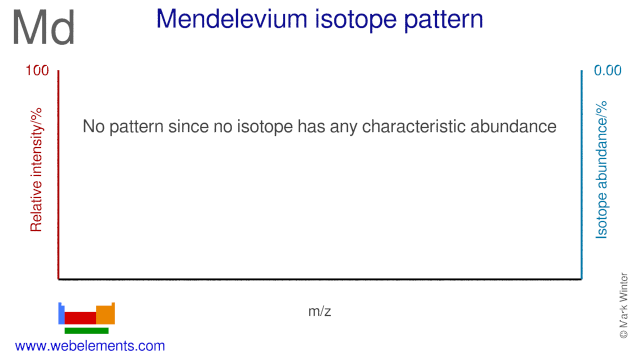Mendelevium - 101Md: the essentials
- Name: mendelevium
- Symbol: Md
- Atomic number: 101
- Relative atomic mass (Ar): [ 258 ] (longest lived isotope)
- Standard state: presumably a solid at 298 K
- Appearance: unknown, but probably metallic and silvery white or grey in appearance
- Classification: Metallic
- Group in periodic table:
- Group name: Actinoid
- Period in periodic table: 7 (actinoid)
- Block in periodic table: f
- Shell structure: 2.8.18.32.31.8.2
- CAS Registry: 7440-11-1
Mendelevium atoms have 101 electrons and the shell structure is 2.8.18.32.31.8.2. The ground state electronic configuration of neutral mendelevium is [Rn].5f13.7s2 and the term symbol of mendelevium is 2F7/2.
Mendelevium: description
Mendelevium is a radioactive rare earth metal named after Dmitri Mendeleev, father of the Periodic Table.
Mendelevium: physical properties
Density of solid: (no data) kg m-3
Molar volume: (no data) cm3
Thermal conductivity: 10 (estimate) W m‑1 K‑1
Mendelevium: heat properties
Melting point: about 1100 [827 °C (1521 °F)] K
Boiling point: (no data) K
Enthalpy of fusion: 20.5 kJ mol-1
Mendelevium: atom sizes
Atomic radius (empirical): (no data) pm
Molecular single bond covalent radius: 173 (coordination number 3) ppm
van der Waals radius: (no data) ppm
Mendelevium: electronegativities
Pauling electronegativity: 1.3 (Pauling units)
Allred Rochow electronegativity: 1.2 (Pauling units)
Mulliken-Jaffe electronegativity: (no data)
Mendelevium: orbital properties
First ionisation energy: 635 (inferred) kJ mol‑1
Second ionisation energy: 1200 kJ mol‑1
Third ionisation energy: 2340 kJ mol‑1
Mendelevium: abundances
Universe: (no data) ppb by weight
Crustal rocks: (no data) ppb by weight
Human: (no data) ppb by weight
Mendelevium: crystal structure

Mendelevium: biological data
Human abundance by weight: (no data) ppb by weight
Mendelevium has no biological role.
Mendelevium: uses
Mendelevium: reactions
Reactions of mendelevium as the element with air, water, halogens, acids, and bases where known.
Mendelevium: binary compounds
Binary compounds with halogens (known as halides), oxygen (known as oxides), hydrogen (known as hydrides), and other compounds of mendelevium where known.
Mendelevium: compound properties
Bond strengths; lattice energies of mendelevium halides, hydrides, oxides (where known); and reduction potentials where known.
Mendelevium: history
Mendelevium was discovered by Glenn T. Seaborg, Albert Ghiorso, Bernard Harvey, Gregory Choppin, Stanley G. Thompson in 1955 at USA. Origin of name: named after Dimitri "Mendeleev", the Russian chemist who contributed so much to the development of the periodic table.Mendelevium: isotopes

Mendelevium: isolation
Isolation: coming soon!
